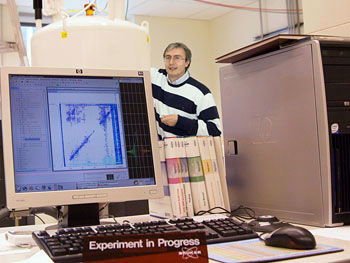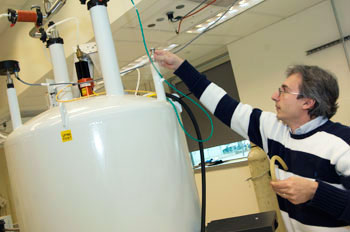Alexander Shekhtman: Raising the Protein Bar
 |
Alexander Shekhtman�s research could lead to therapies for the complications of Type I and Type II diabetes. (Photo Mark Schmidt) |
The steady thrum and chirp of the pumps in the lab sound vaguely like breathing. Alexander Shekhtman moves from the Nuclear Magnetic Resonance (NMR) spectrometer to a computer screen bright with a jagged graph of pink and baby blue. Through the spectrometer, Shekhtman is looking at protein molecules bumping into each other while still inside a living cell.
"It's about structural interaction, how atoms stick to each other,� says Shekhtman. �When you have an understanding how biological molecules react at atomic resolutions in the cell, rather than as purified proteins in vitro, you're closer to the solution, just a few steps away from being able to design treatments."
Shekhtman�s research could lead to therapies for the complications of Type I and Type II diabetes. The University at Albany biophysicist and chemist is zeroing in on the disease with an $800,000 grant from the American Diabetes Association, using his unique method of observing and measuring protein interactions in living cells. The proteins are the molecules that do things, he says. They make cells, and they're the mediators of cellular function. They can cause the disease, too.
In a 2006 paper published in "Nature Methods," the scientist and his colleagues first described his STINT-NMR (STructural INTeractions NMR) method, which uses bacteria to first make proteins called target proteins that can be seen by using NMR spectrometer, followed by unmarked (known as "NMR silent") proteins that bind to the first protein. When two protein molecules bump and bind, they cause structural changes that reveal themselves through chemical shifts on the target protein, changes that can be monitored by a powerful NMR spectrometer.
 |
STINT-NMR (STructural INTeractions NMR) allows researchers to observe protein interactions in living cells. (Photo Mark Schmidt) |
The development of STINT-NMR caused ripples in the structural biology universe, and tagged Shekhtman a world expert in in-cell NMR spectroscopy. Key to his discovery were the lab's powerful 500 and 700 MHz NMR spectrometers.
He works with numerous collaborators, including graduate students, post-doctorate researchers, and undergrad researchers. He is particularly supportive of beginning research at the undergraduate level because, he says, "It's beneficial for the program and for the student. They see the results of their research, and are inspired to want their Master's degree, even Ph.D.s, and on to bigger research."
The native of Belarus earned his doctorate at UAlbany and, after several years as a research associate at The Rockefeller University and Manhattan's New York Structural Biology Center, returned to the university faculty. His optimism about the research applications for preventing complications of Type I and Type II diabetes is bolstered by his lab's location in the Life Sciences Building, the university's hub for biomedical research. With interconnected lab space and common areas for meetings and socializing, the building was designed for intellectual exchange and collaboration among its tenants and researchers.
"Today, all sciences are related," he says. "Here we have molecular biologists, chemists, cell biologists, even psychologists and physicists. It is whole. The university has really developed a much better program by putting us all together."
![]() For more news, subscribe to UAlbany's RSS headline feeds
For more news, subscribe to UAlbany's RSS headline feeds


